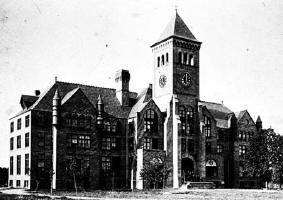
Trinity College began in 1839 when Methodist and Quaker farm families in Randolph County joined together to start a subscription school named Union Institute. When the school's first principal, Brantley York, moved on to other church-related tasks in 1842, his young assistant, Braxton Craven, assumed the responsibility for the school. For the following four decades, Craven waged an unceasing effort to keep the school alive.
Craven's chief challenge was to find financial support, and in 1849 he turned to the state for a recharter of the school as Normal College, with teacher training as its prime mission. Financial support continued to be scarce, however, and in 1859 Craven sought support from the North Carolina Methodists. Under Methodist sponsorship, the college changed its name to Trinity College and adopted a liberal arts curriculum. Though financial difficulties remained, enrollment grew and the college managed to survive the Civil War and Reconstruction without closing.
Craven's death in 1882 after 40 years of leadership brought more uncertainty to Trinity College, but the intervention and leadership of three well-to-do Methodist businessmen-J. W. Alspaugh, Julian S. Carr, and James A. Gray-saved the school. A new president, the Yale-educated John F. Crowell, improved the curriculum and, more important, conceived the idea of moving the college from its isolated, rural setting to a more vibrant, urban location. With key support from Washington Duke and fellow Methodist and townsman Julian S. Carr, Trinity College moved to Durham, opening there in 1892. The Duke family continued its commitment to the institution, and in 1896, when Washington Duke offered to give the college $100,000 for endowment if it would admit women on an "equal footing" with men, the college promptly accepted the offer, making Trinity a pioneer in the South in women's education.
With steady financial support from the Duke family and a growing reputation for quality, Trinity had become by the time of World War I one of the stronger liberal arts colleges in the South. Soon after the war, President William P. Few revived earlier dreams of making Trinity a university. With the help of Benjamin N. Duke and others, Few approached the wealthiest member of the family, James B. Duke, with the idea. J. B. Duke's establishment of the Duke Endowment in 1924 gave Few the funds to achieve his goal. Trinity thus became and remained what Few conceived of as the liberal arts "heart" of Duke University.